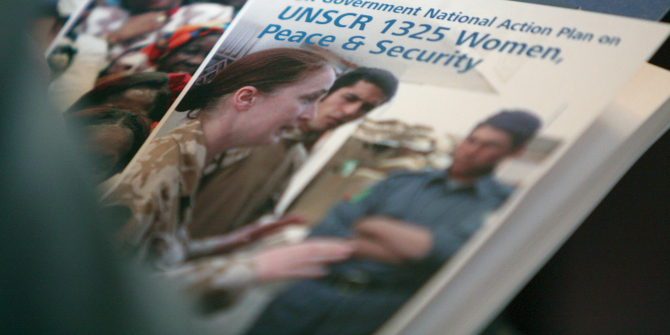Why, even when women have not been intimately involved in conflicts, do peace agreements so frequently contain reference to their rights? In Windows of Opportunity: How Women Seize Peace Negotiations for Political Change, Miriam J. Anderson examines how provisions relating to gender and women’s rights have been part of peace negotiations through three case studies of conflict resolution in Burundi, Macedonia and Northern Ireland as well as discussion of 195 peace agreements signed between 1975-2011. Jennifer Thomson welcomes this book for exploring questions that are of fundamental importance to feminist work on post-conflict societies and peace negotiations.
Windows of Opportunity: How Women Seize Peace Negotiations for Political Change. Miriam J. Anderson. Oxford University Press. 2016.
 Why, even when women have not been intimately involved in conflicts, do peace agreements contain reference to their rights? Women are rarely key instigators of conflict, yet 40 per cent of all peace agreements from 1975-2011 contain at least one specific reference to women. Furthermore, the majority of these provisions refer not to local customs, laws or practices, but rather to the international discourse on women’s rights. Why is this? And what are the key factors that suggest the likelihood of including references to women’s rights in peace agreements? Such are the central questions in Miriam J. Anderson’s Windows of Opportunity: How Women Seize Peace Negotiations for Political Change, which provides an in-depth comparison of the peace agreements that brought an end to conflicts in Northern Ireland, Burundi and Macedonia.
Why, even when women have not been intimately involved in conflicts, do peace agreements contain reference to their rights? Women are rarely key instigators of conflict, yet 40 per cent of all peace agreements from 1975-2011 contain at least one specific reference to women. Furthermore, the majority of these provisions refer not to local customs, laws or practices, but rather to the international discourse on women’s rights. Why is this? And what are the key factors that suggest the likelihood of including references to women’s rights in peace agreements? Such are the central questions in Miriam J. Anderson’s Windows of Opportunity: How Women Seize Peace Negotiations for Political Change, which provides an in-depth comparison of the peace agreements that brought an end to conflicts in Northern Ireland, Burundi and Macedonia.
The central component of the book is three case studies of these respective peace agreements. The three accounts provide richly detailed insight into an aspect of peace negotiations which is often marginalised in mainstream literature – women’s organisation and collective activity. Anderson considers two positive examples that included reference to women in the text of the final agreement (Northern Ireland and Burundi), and one negative example which did not (Macedonia).
In the positive case of Northern Ireland, the Good Friday Agreement of 1998 actually contained only a few specific references to women, and these are, as Anderson acknowledges, ‘aspirational only – without specific measures to implement the principles they espouse’ (77). Anderson details how women organised to form a new political party, the Northern Ireland Women’s Coalition, and in doing so, argued both for women’s inclusion in the discussions that lead to the peace agreement and for substantive reference to women in the final document.
In Burundi, the Arusha Accords of 2000 included reference to a 30 per cent quota for women’s political representation. Anderson’s account of women’s activism in Burundi in this moment is particularly interesting, considering the interplay of national and international forces that delivered on women’s rights. She describes a process by which the United Nations Development Fund for Women (UNIFEM) supported women’s activism on the ground, and ‘sought to create an example of women’s participation in a peace process to use in their campaign for a Security Council resolution on women, peace and security’ (76). In both of these positive examples, Anderson argues that it is through the influence of transnational advocacy – either through direct influence in the case of Burundi, or organically through grassroots activists’ previous transnational work in the case of Northern Ireland – that international discourse around women and human rights makes it into peace agreements.
 Image Credit: Launch event of the UK Government National Action Plan on United Nations Security Council Resolution 1325 Women, Peace & Security in London, 25 November 2010 (Foreign and Commonwealth Office, OGL)
Image Credit: Launch event of the UK Government National Action Plan on United Nations Security Council Resolution 1325 Women, Peace & Security in London, 25 November 2010 (Foreign and Commonwealth Office, OGL)
Her negative example is Macedonia. The Ohrid Framework Agreement of 2001 contains no specific reference to women in its text. She argues that the far shorter length of the conflict compared to that in Northern Ireland and Burundi, and the difficulties that women’s groups had in avoiding ethnic divisions and tensions, inhibited the inclusion of women’s rights in the peace agreement. Interestingly, Anderson finds little sense that the passing of United Nations Security Council Resolution 1325 on Women, Peace and Security in 2000 helped women’s rights advocates in any way in Macedonia, noting that ‘women involved in lobbying for access to the peace process […] were not fully aware of the implications of Security Council Resolution 1325’ (100). Such a finding, and this section on Macedonia in particular, will be of key interest to feminist security studies scholars.
Anderson’s final substantive chapter is a quantitative consideration of 195 peace agreements signed between 1975 and 2011. Such an inclusion is an important reminder of the ways in which quantitative methods can be used in this type of research, which predominantly relies on qualitative work, and also compounds Anderson’s central finding that longer conflicts are more likely to include women’s rights in their peace agreements. Also, reflecting the Macedonia case, she finds that the passage of UNSCR 1325 has had little impact on the inclusion of references to women’s rights in peace agreements.
Anderson’s work is a comprehensive, in-depth overview of an aspect of peace agreements that is too often forgotten in mainstream literature. Yet her work raises many questions for future research. Her interest in the creation of peace agreements does not take us further into their implantation in post-conflict societies. In the case of Northern Ireland, for example, in spite of the inclusion of a specific reference to women’s rights in the Good Friday Agreement, women’s representation in Stormont has languished far below the rest of the devolved UK bodies, and key women’s rights (including access to abortion) are still denied. Is reference to women’s rights in peace agreements enough to ensure their equality in post-conflict countries?
Furthermore, what about women who were politically active in these countries, but not through women-specific groupings? Women may not generally be prominent in conflict, but they can still be key figures in political parties and groupings that function along ethnic or national lines. The focus on women’s activism in feminist scholarship such as Anderson’s can implicitly add to the sense that all women in conflict situations are working for justice and peace. How can we understand women’s political involvement in divided societies, such as those that Anderson considers here, when they are not concerned with women’s rights specifically?
In addition, as Anderson stresses throughout all three of her case studies, women’s groups are most successful when they avoid central tensions in these conflicts (the constitutional question in the case of Northern Ireland, for example). She describes the All-Women’s Peace Conference organised by UNIFEM in the run-up to the Arusha Accords, which ‘bracketed the contentious issues of the conflict, allowing women to focus on subjects that would not divide them along ethnic lines’ (74). This finding raises troubling questions about women’s involvement in peace processes – can women only be involved when they are sidelined, focusing on (what can often be a very narrow remit of) ‘women’s issues’?
The questions that this book provokes are of fundamental importance to feminist work on post-conflict societies and peace negotiations; Windows of Opportunity also provides much-needed comparative work. This book will be of key interest to social scientists working on transitional justice, feminist security studies and gendered issues in post-conflict societies.
Jennifer Thomson is an ESRC-funded doctoral student at the School of Politics and IR, Queen Mary University of London. Her thesis focuses on post-conflict Northern Ireland and abortion policy. You can read more about her work here: http://bit.ly/1RTw95B. She tweets @jencthomson. Read more reviews by Jennifer Thomson.
Note: This review gives the views of the author, and not the position of the LSE Review of Books blog, or of the London School of Economics.







